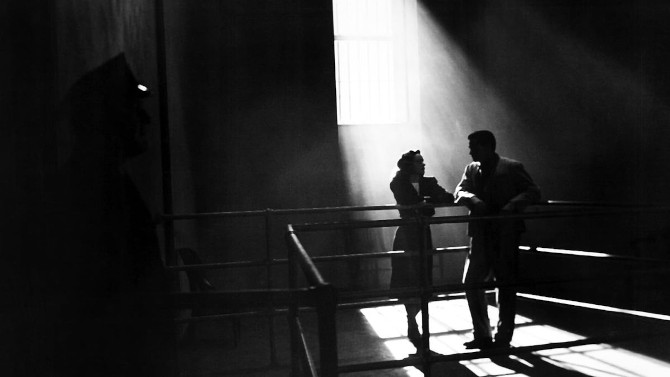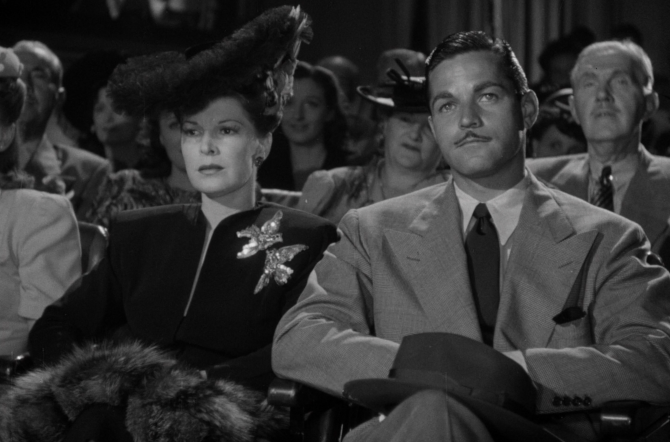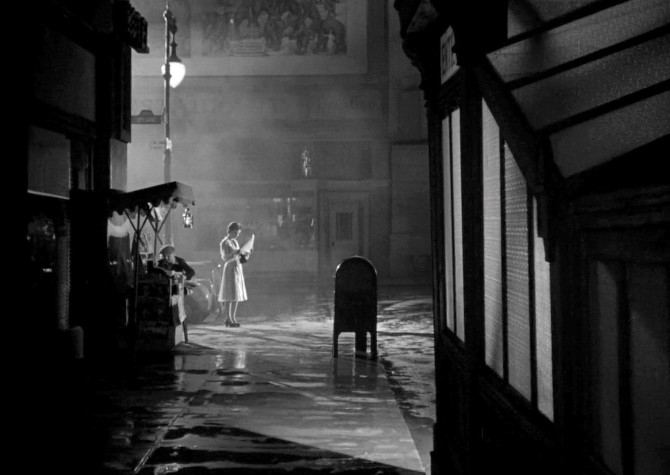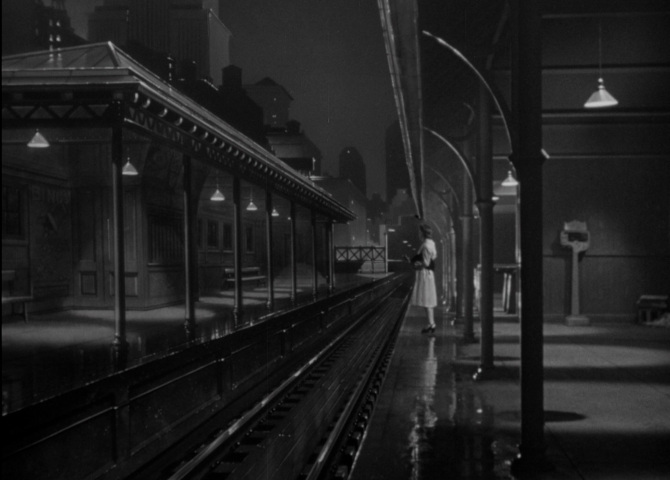A man, scorned by his ungrateful wife on their anniversary (he had front row tickets to a well reviewed live show), buries his head in alcohol at the local bar, only to stumble into a mysterious thirty-something woman in an equally sour mood (she does have quite a fabulous hat on though). Deciding to go to the show together (with the caveat that they are not to divulge their names to each other), it is a wonderful evening that buoys their spirits a bit. A seemingly serendipitous love story. . . the only problem, said man returns home to find three detectives in his living room waiting for him, as his wife has been strangled to death by some necktie wielding maniac.
The introduction to the 1944 film noir crime drama Phantom Lady, directed by Robert Siodmak (and based on a Cornell Woolrich novel of the same name – under his pseudonym William Irish), Scott Henderson (Alan Curtis) is the unlucky chap mentioned above. His only alibi. . . the unknown woman, who will be so elusive that he will start to wonder if he simply imagined her (it doesn’t help that he cannot remember the woman in finer detail since learning of his wife’s murder).
Escorted by Inspector Burgess (Thomas Gomez) to those places he visited with the dame on that fateful evening, every person they meet, be it the Bartender (Andrew Tombes), the Taxi Driver (Matt McHugh), Cliff the drummer (Elisha Cook Jr.), or the star of the show, Estela Monteiro (Aurora Miranda – sister of Carmen) – who was furious that the phantom lady was wearing the same hat as her, claims that they don’t remember anyone with him.
Pinned for the murder (and quickly jailed), he has almost nowhere to turn. Thankfully, he is completely unaware that his faithful secretary, Carol Richman (Ella Raines) – affectionately called Kansas by her friends (as that is where she is from), is in love with him. . . and she quickly takes up the mantle of investigating the case. Soon, Henderson’s best friend, Jack Marlow (Franchot Tone), returns from South America and joins the search. Intriguingly, Inspector Burgess’ instincts tell him that the man is innocent and he offers his services as well. Will this ragtag team of amateur sleuths (and on-his-private-time cop) be able to trace this perplexing woman and solve her part in the murder? Who is pulling the strings – could it really be this phantom lady? And, will Henderson be saved at the last moment. . . and if so, will he finally realize that his true love is sitting right outside his office door?
 In Siodmak’s first noir (he would continue to make some of the sub-genre’s best – think The Killers, The Spiral Staircase, Cry of the City, and Criss Cross – all released within a five year period), you can immediately see the combination of a Hitchcockian psychological thriller, the stylistic flair seen in German expressionism, and the wartime cynicism of the day. Filled with shadow and light (that sets a dark, brooding atmosphere), and equally as shady characters (as always, Elisha Cook Jr. shines, this time as a flirty, big talking percussionist), both combine for quite the feature. But it is not simply the style and acting that elevates the movie, but also its intoxicating fusion of maniacal subterfuge and unfortunate happenstance. . . an exciting narrative that finds our poor protagonists (for both Harrison and Carol Richman fit the bill) in danger at every turn, their lives (and possibly a future love story) hanging in the balance at the hands of some unknown psychopath.
In Siodmak’s first noir (he would continue to make some of the sub-genre’s best – think The Killers, The Spiral Staircase, Cry of the City, and Criss Cross – all released within a five year period), you can immediately see the combination of a Hitchcockian psychological thriller, the stylistic flair seen in German expressionism, and the wartime cynicism of the day. Filled with shadow and light (that sets a dark, brooding atmosphere), and equally as shady characters (as always, Elisha Cook Jr. shines, this time as a flirty, big talking percussionist), both combine for quite the feature. But it is not simply the style and acting that elevates the movie, but also its intoxicating fusion of maniacal subterfuge and unfortunate happenstance. . . an exciting narrative that finds our poor protagonists (for both Harrison and Carol Richman fit the bill) in danger at every turn, their lives (and possibly a future love story) hanging in the balance at the hands of some unknown psychopath.
The score must also be mentioned, for music director Hans J. Salter and composer Eddie Cherkose work their magic. . . minimal, yet memorable, nearly every moment is diegetic deliciousness – be it the live show, or a wild jazzy ragtime number in a sketchy storage room (which is erotically charged – you’ll understand that statement when you see it), the pace and editing moving rhythmically to the beat.
A most memorable and quite unique crime picture, Phantom Lady was an important film in many ways. On top of being Siodmak’s first film noir, as well as helping shape the growing sub-genre, it was also producer Joan Harrison’s first credit in that field. A woman who joined the industry under the wing of Alfred Hitchcock (starting as his personal secretary in England, she soon worked her way up to getting writing credits on many of the Master of Suspense’s best early motion pictures in the United States – think Rebecca, Foreign Correspondent and Suspicion), she would go on to produce seven more films over the next six years (one of which was the excellent Ride the Pink Horse) and a number of television shows over the next two decades (including reuniting with her former mentor for Alfred Hitchcock Presents and The Alfred Hitchcock Hour). Though to some this might not seem like a big deal, it really was – so very rare for a woman to get this much power in the 1940s and beyond, she is a true underdog success story. So, free this one from historic obscurity. . . it is a noir gem worth befriending.




